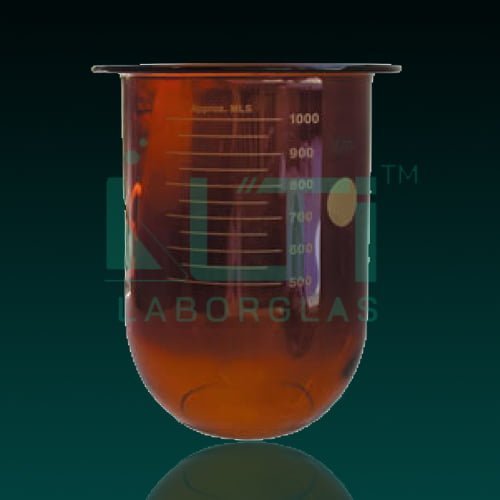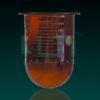- Made From Heat Resistant, Low Expansion 3.3 Borosilicate Glass
- Complies with DIN ISO 3585 & USP standard
- Smooth hemispherical base
- Graduated in interval of 50ml
- Vessels confirms to all requirements of USP
| PART No. | Capacity (ml) | Dia (mm) | Height (mm) | PACK Qty. |
| 5760-1000 | 1000 | 124 | 173 | 6 |
Here are some general considerations regarding potential uses:
- Light-Sensitive Samples: Amber-colored glass provides protection against light, making it suitable for samples that may be light-sensitive. In dissolution testing, where pharmaceutical compounds may degrade when exposed to light, using amber glass can help mitigate this.
- Dissolution Testing: Flasks with side cuts are often designed for use in dissolution testing. This involves assessing the rate at which a solid dosage form dissolves under standardized conditions, typically in a dissolution apparatus.
- Standardization and Compatibility: The design of the amber flasks with side cuts may adhere to DIN/ISO standards or other relevant standards to ensure standardization and compatibility with dissolution apparatus and equipment. This is crucial for maintaining consistency and reproducibility in dissolution testing across different laboratories.
- Side Cuts for Improved Fluid Dynamics: The inclusion of side cuts in the flask design may be aimed at improving fluid dynamics during dissolution testing. Side cuts can influence the flow of the dissolution medium around the dosage form, helping to ensure uniform conditions.
- Enhanced Sampling and Analysis: Side cuts can facilitate improved access to the dissolution medium for sampling or the addition of reagents. This can be beneficial for real-time analysis or monitoring of the dissolution process.
- Preventing Edge Effects: Side cuts may help prevent edge effects during dissolution testing, ensuring that the dissolution medium flows uniformly around the dosage form.
- Minimizing Contamination: The flask design may aim to minimize the risk of contamination during dissolution testing, providing a controlled environment for the dissolution process.
- Conformance to Regulatory Standards: If used in pharmaceutical testing, the amber flasks with side cuts would need to adhere to regulatory standards, such as those outlined by the USP or other applicable regulatory bodies.







